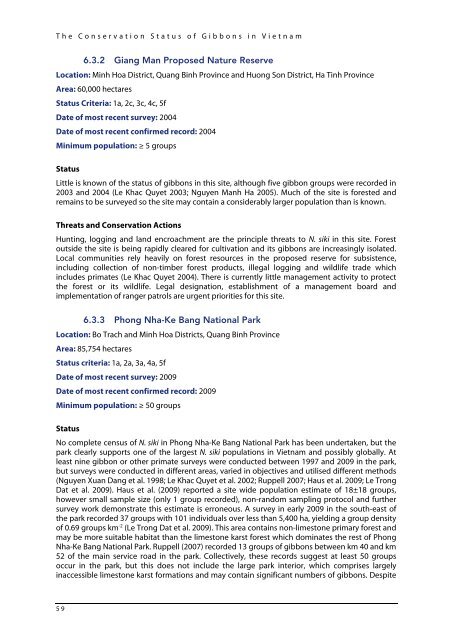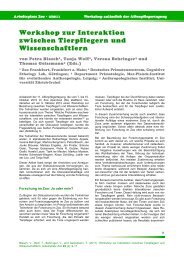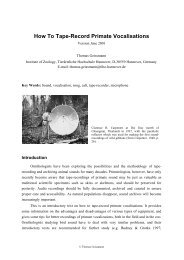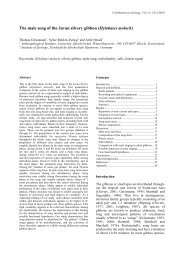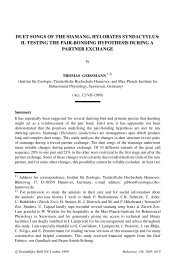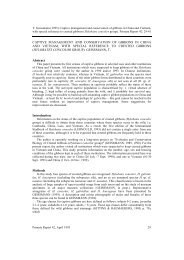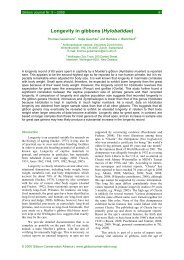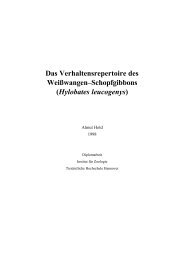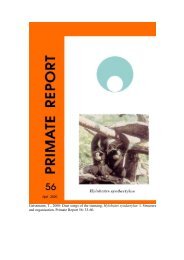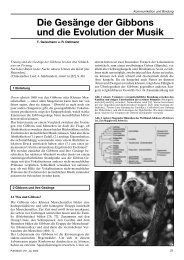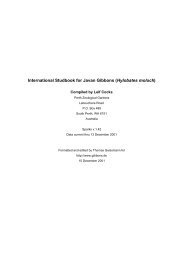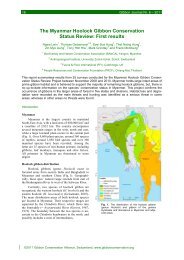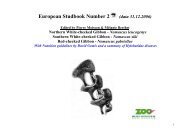The Conservation Status of Gibbons in Vietnam - Gibbon Research ...
The Conservation Status of Gibbons in Vietnam - Gibbon Research ...
The Conservation Status of Gibbons in Vietnam - Gibbon Research ...
You also want an ePaper? Increase the reach of your titles
YUMPU automatically turns print PDFs into web optimized ePapers that Google loves.
<strong>The</strong> <strong>Conservation</strong> <strong>Status</strong> <strong>of</strong> <strong><strong>Gibbon</strong>s</strong> <strong>in</strong> <strong>Vietnam</strong>6.3.2 Giang Man Proposed Nature ReserveLocation: M<strong>in</strong>h Hoa District, Quang B<strong>in</strong>h Prov<strong>in</strong>ce and Huong Son District, Ha T<strong>in</strong>h Prov<strong>in</strong>ceArea: 60,000 hectares<strong>Status</strong> Criteria: 1a, 2c, 3c, 4c, 5fDate <strong>of</strong> most recent survey: 2004Date <strong>of</strong> most recent confirmed record: 2004M<strong>in</strong>imum population: ≥ 5 groups<strong>Status</strong>Little is known <strong>of</strong> the status <strong>of</strong> gibbons <strong>in</strong> this site, although five gibbon groups were recorded <strong>in</strong>2003 and 2004 (Le Khac Quyet 2003; Nguyen Manh Ha 2005). Much <strong>of</strong> the site is forested andrema<strong>in</strong>s to be surveyed so the site may conta<strong>in</strong> a considerably larger population than is known.Threats and <strong>Conservation</strong> ActionsHunt<strong>in</strong>g, logg<strong>in</strong>g and land encroachment are the pr<strong>in</strong>ciple threats to N. siki <strong>in</strong> this site. Forestoutside the site is be<strong>in</strong>g rapidly cleared for cultivation and its gibbons are <strong>in</strong>creas<strong>in</strong>gly isolated.Local communities rely heavily on forest resources <strong>in</strong> the proposed reserve for subsistence,<strong>in</strong>clud<strong>in</strong>g collection <strong>of</strong> non-timber forest products, illegal logg<strong>in</strong>g and wildlife trade which<strong>in</strong>cludes primates (Le Khac Quyet 2004). <strong>The</strong>re is currently little management activity to protectthe forest or its wildlife. Legal designation, establishment <strong>of</strong> a management board andimplementation <strong>of</strong> ranger patrols are urgent priorities for this site.6.3.3 Phong Nha-Ke Bang National ParkLocation: Bo Trach and M<strong>in</strong>h Hoa Districts, Quang B<strong>in</strong>h Prov<strong>in</strong>ceArea: 85,754 hectares<strong>Status</strong> criteria: 1a, 2a, 3a, 4a, 5fDate <strong>of</strong> most recent survey: 2009Date <strong>of</strong> most recent confirmed record: 2009M<strong>in</strong>imum population: ≥ 50 groups<strong>Status</strong>No complete census <strong>of</strong> N. siki <strong>in</strong> Phong Nha-Ke Bang National Park has been undertaken, but thepark clearly supports one <strong>of</strong> the largest N. siki populations <strong>in</strong> <strong>Vietnam</strong> and possibly globally. Atleast n<strong>in</strong>e gibbon or other primate surveys were conducted between 1997 and 2009 <strong>in</strong> the park,but surveys were conducted <strong>in</strong> different areas, varied <strong>in</strong> objectives and utilised different methods(Nguyen Xuan Dang et al. 1998; Le Khac Quyet et al. 2002; Ruppell 2007; Haus et al. 2009; Le TrongDat et al. 2009). Haus et al. (2009) reported a site wide population estimate <strong>of</strong> 18±18 groups,however small sample size (only 1 group recorded), non-random sampl<strong>in</strong>g protocol and furthersurvey work demonstrate this estimate is erroneous. A survey <strong>in</strong> early 2009 <strong>in</strong> the south-east <strong>of</strong>the park recorded 37 groups with 101 <strong>in</strong>dividuals over less than 5,400 ha, yield<strong>in</strong>g a group density<strong>of</strong> 0.69 groups km -2 (Le Trong Dat et al. 2009). This area conta<strong>in</strong>s non-limestone primary forest andmay be more suitable habitat than the limestone karst forest which dom<strong>in</strong>ates the rest <strong>of</strong> PhongNha-Ke Bang National Park. Ruppell (2007) recorded 13 groups <strong>of</strong> gibbons between km 40 and km52 <strong>of</strong> the ma<strong>in</strong> service road <strong>in</strong> the park. Collectively, these records suggest at least 50 groupsoccur <strong>in</strong> the park, but this does not <strong>in</strong>clude the large park <strong>in</strong>terior, which comprises largely<strong>in</strong>accessible limestone karst formations and may conta<strong>in</strong> significant numbers <strong>of</strong> gibbons. Despite59


